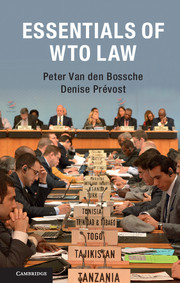Book contents
- Frontmatter
- Contents
- List of figures and tables
- Preface
- List of abbreviations
- Table of cases
- 1 International trade and the law of the WTO
- 2 Rules on non-discrimination
- 3 Rules on market access
- 4 Trade liberalization and other societal values and interests
- 5 Rules on unfair trade
- 6 Rules regarding harmonization of national regulation
- 7 The institutional aspects of the WTO
- 8 The WTO dispute settlement system
- Online resources
- Index
- References
7 - The institutional aspects of the WTO
- Frontmatter
- Contents
- List of figures and tables
- Preface
- List of abbreviations
- Table of cases
- 1 International trade and the law of the WTO
- 2 Rules on non-discrimination
- 3 Rules on market access
- 4 Trade liberalization and other societal values and interests
- 5 Rules on unfair trade
- 6 Rules regarding harmonization of national regulation
- 7 The institutional aspects of the WTO
- 8 The WTO dispute settlement system
- Online resources
- Index
- References
Summary
Introduction
The World Trade Organization (WTO) was established under the WTO Agreement and became operational on 1 January 1995. The WTO Agreement was signed on 15 April 1994 in Marrakesh, Morocco, by the countries and customs territories that had participated in the Uruguay Round of multilateral trade negotiations (hereinafter the Uruguay Round) from 1986 to 1993. The establishment of the WTO is seen by many as the most important result of the Uruguay Round. Although the WTO is the youngest of the major international intergovernmental organizations, it is arguably among the most influential international organizations in these times of economic globalization.
The origins of the WTO lie in the General Agreement on Tariffs and Trade of 1947 (GATT 1947), which had functioned for almost fifty years as a de facto international organization for trade. At the end of the 1940s, the international community had not succeeded in establishing an international organization for trade alongside the newly created international economic organizations, namely the World Bank and the International Monetary Fund (IMF). Although the Havana Charter establishing an ‘International Trade Organization’ was concluded in 1948, it never came into force because of the refusal of the US Congress to approve this agreement. The GATT 1947, which was conceived as a multilateral agreement for the reduction of tariffs and other barriers to trade, and not as an international organization, gradually and very pragmatically, took on the central tasks of the ‘stillborn’ International Trade Organization. The decisions, procedures and customary practices of the GATT 1947 still guide the WTO (Article XVI:1 of the WTO Agreement).
The GATT 1947 had much success with regard to the reduction of customs duties, particularly on industrial products. However, it was less successful in reducing non-tariff barriers to trade. During the Uruguay Round, the conviction gradually grew that the international community needed a fully fledged international organization to efficiently guide and regulate the increasingly complex trade relations between countries. This conviction, championed by Canada, the European Union (EU), and Mexico but not by the United States, finally led to the establishment of the WTO.
Objectives
Pursuant to the Preamble of the WTO Agreement, the ultimate objectives of the WTO are:
• the increase of standards of living;
• the attainment of full employment;
• the growth of real income and effective demand; and
- Type
- Chapter
- Information
- Essentials of WTO Law , pp. 232 - 258Publisher: Cambridge University PressPrint publication year: 2016
References
- 2
- Cited by



